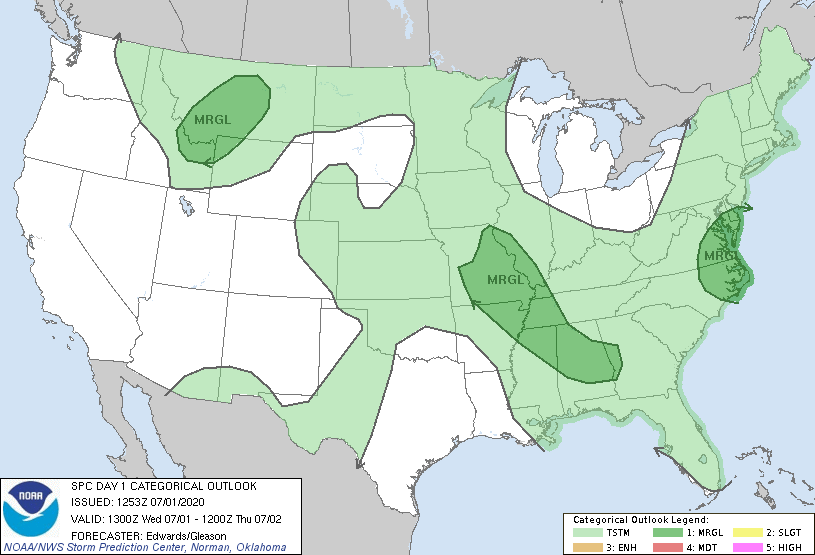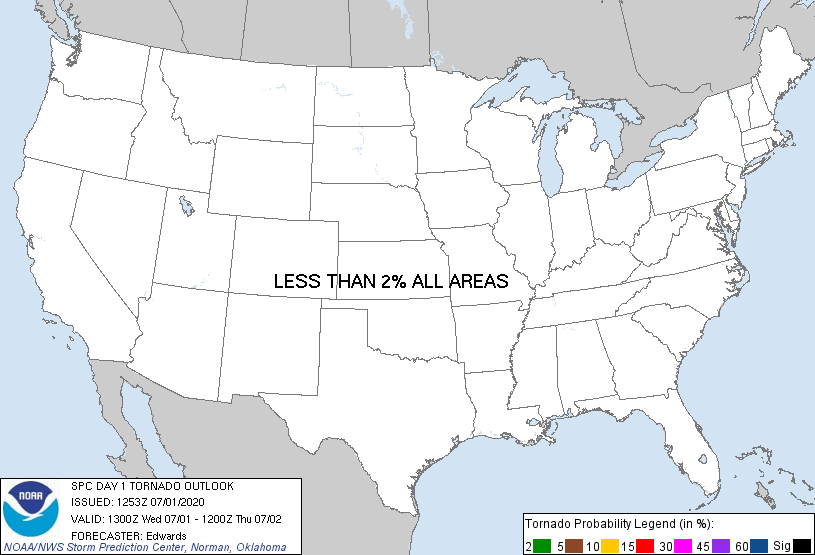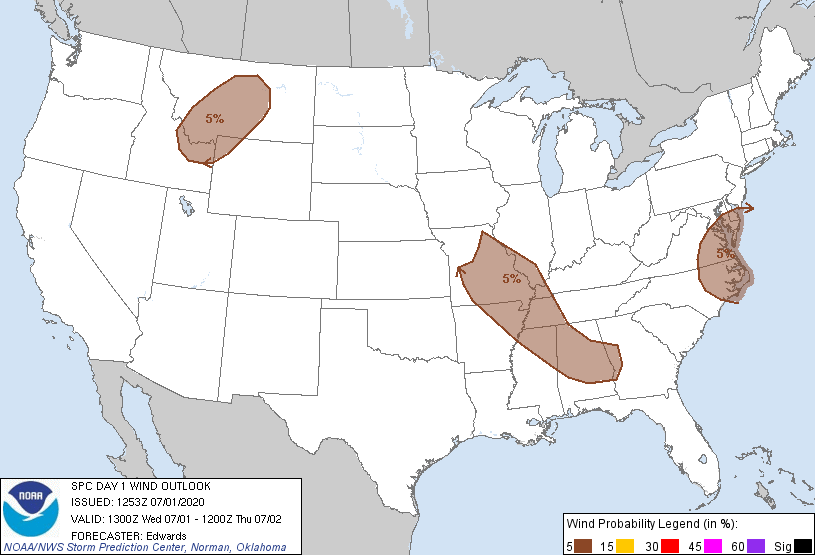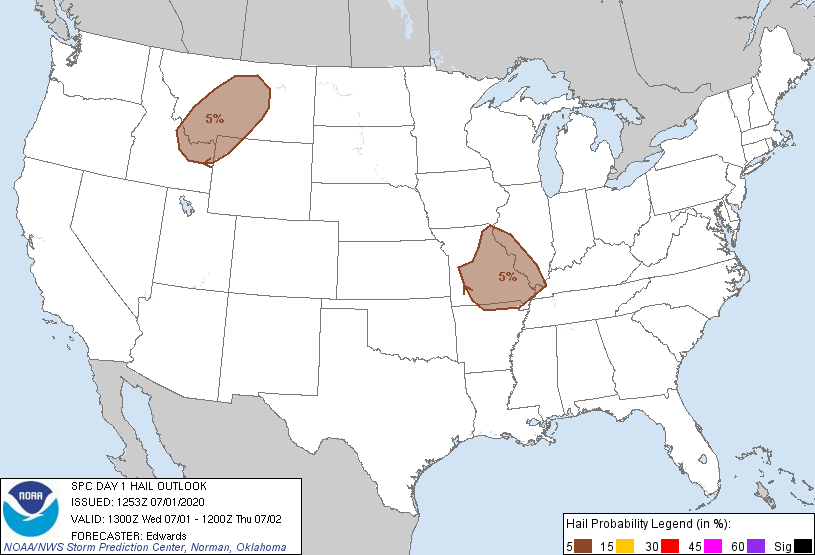SPC AC 011253
Day 1 Convective Outlook
NWS Storm Prediction Center Norman OK
0753 AM CDT Wed Jul 01 2020
Valid 011300Z - 021200Z
...THERE IS A MARGINAL RISK OF SEVERE THUNDERSTORMS OVER PARTS OF
THE NORTHERN ROCKIES...MISSOURI ACROSS MID-SOUTH TO PARTS OF
GEORGIA/ALABAMA...AND THE TIDEWATER REGION FROM THE DELMARVA TO
NORTH CAROLINA...
...SUMMARY...
Marginally severe thunderstorms are possible today into this evening
over parts of these regions: northern Rockies, Missouri across
Mid-South to parts of Georgia/Alabama, and the Tidewater region from
the Delmarva to North Carolina.
...Synopsis...
The basic upper-air pattern will remain characterized by central
CONUS ridging, with mean troughs over the West Coast States and East
Coast. A slow-moving, compact, mid/upper-level cyclone is evident
in moisture-channel imagery over New England, with trough
southwestward to the southern Appalachians. The low is forecast to
move slowly southeastward and devolve to an open wave through the
period. By 12Z tomorrow, the resulting trough should extend from
the Bay of Fundy across Cape Cod to the coastal Carolinas, with
broadly cyclonic flow extending farther southwest across much of
MS/AL/GA, northern FL, and the northeastern Gulf. Convectively
generated vorticity maxima will traverse that flow field between MO
and GA. In the Northwest, a complex cyclone now over the northern
Rockies will wrap northward to northwestward over southern/central
BC as it absorbs an initially separate perturbation now over the AK
Panhandle.
At the surface, 11Z analysis depicted a low over coastal NH, nearly
stacked with the mid/upper level cyclone center. A wavy cold front
extended from there across Atlantic waters and the Delmarva to
another low over central SC, then across central GA to central AL.
With modulation by convective outflow, the boundary extended
northwestward from there across central MO as a warm front. A
secondary cold front was drawn from the New England low over PA, OH
and northeastern IL, becoming a warm front across northern MN to a
surface low over southwestern MB. A cold front was analyzed from
there southeastward over western MN and eastern NE, behind an
outflow boundary, then southwestward across central get better-
defined today as the warm-sector boundary layer becomes seasonally
hot.
...MO to Mid-South/Tennessee Valley region and Southeast...
A long-lasting area of strong-severe thunderstorms, astride the
frontal zone, has been fluctuating in organization below and just
above severe levels, for much of the prior overnight into this
morning. This activity appears to have peaked over and northwest of
the KC metro area, and has resumed a weakening trend, as evident in
radar and satellite imagery. Still, substantial isallobaric and
theta-e perturbations have been generated. These may persist
southeastward across MO into a very moist and diabatically
destabilizing boundary layer, long enough to encourage additional,
potentially severe convective organization later this morning into
afternoon. Renewed development in such a regime, with weak deep
shear but MLCAPE in the 3000-4000 J/kg range, may again pose a
threat for severe gusts -- especially if enough convection can
aggregate a cold pool to augment the pre-existing perturbations.
For now, too many mesoscale and storm-scale uncertainties remain to
assign a specific area of more-concentrated, unconditional severe-
wind threat. Synoptic and convection-allowing progs have varied
considerably from each other and run to run, which is not that
surprising, given all the mixed signals environmentally and in terms
of ingredients needed for substantial cold-pool rejuvenation.
However, the marginal threat area has been widened to accommodate a
range of reasonable track/width scenarios for the lingering low/
middle-level perturbation and associated convective potential. An
upgrade within this corridor is quite possible in a future outlook
package, as mesoscale trends and 12Z and later guidance warrant.
Additional strong/briefly severe convection may develop across parts
of AL/western GA into the afternoon in association with a separate
MCV and initially nonsevere convective process no moving
southeastward across central AL and northwestern MS. The outflow
boundary produced by this activity also should reinforce the frontal
zone northwestward into the Mid-South as a potential instability
gradient to focus development in those areas, either anew or with
the MO perturbation.
...Northern Rockies...
As the complex mid/upper cyclone relocates northward, a shortwave
trough and associated vorticity max now in the interior Northwest
should pivot eastward toward this region. The associated increase
in large-scale lift aloft, combined with steepening of low-level
lapse rates through diabatic heating, will destabilize a deep layer
and weaken MLCINH -- preferentially over the higher terrain first,
near the ID/MT border. In that area, widely scattered to scattered
thunderstorms should form this afternoon, moving northeastward with
the potential for isolated severe gusts and/or hail. Favorable deep
shear and steep deep-layer lapse rates, atop pockets of deep/well-
mixed low-level conditions, will foster at least isolated severe
potential. A limiting factor is lack of more-robust moisture, and
the overall threat should diminish this evening over north-central/
northeastern MT.
...Tidewater region, adjacent coastal plain...
Widely scattered thunderstorms are possible this afternoon into
early evening, developing as the approach of the mid/upper trough
(and related large-scale ascent) coincide with strong diabatic
heating, rich low-level moisture, and related weakening of MLCINH.
Forecast soundings suggest a deep buoyancy layer, characterized by
1500-2000 J/kg of peak preconvective MLCAPE. Beneath that, a
well-mixed subcloud layer with steep boundary-layer lapse rates
should develop in support of localized strong to isolated severe
gust potential. Weak low- to middle-level flow and lack of
substantial vertical shear will limit convective organization, and
both coverage and intensity should diminish this evening as slow
diabatic surface cooling proceeds in the moist airmass.
..Edwards/Gleason.. 07/01/2020
CLICK TO GET WUUS01 PTSDY1 PRODUCT
NOTE: THE NEXT DAY 1 OUTLOOK IS SCHEDULED BY 1630Z
|



